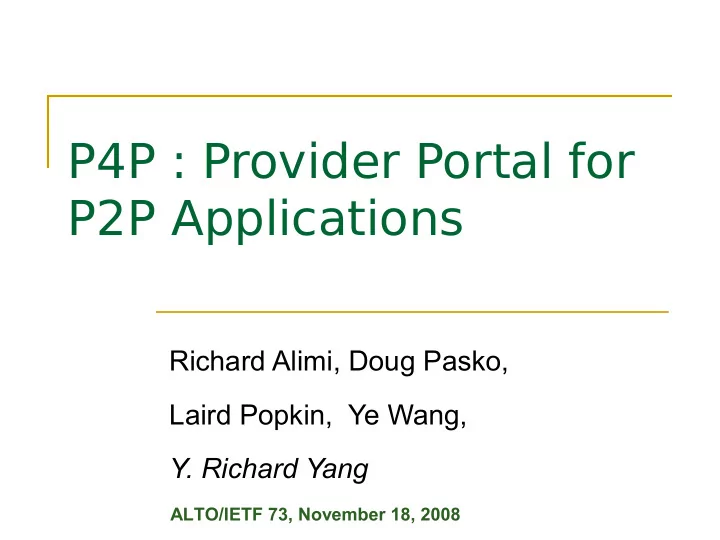

P4P : Provider Portal for P2P Applications Richard Alimi, Doug Pasko, Laird Popkin, Ye Wang, Y. Richard Yang ALTO/IETF 73, November 18, 2008
P4P Portal Services Location Portal Service pDistance Portal Service
Location Portal Service Allows an ISP to aggregate the Internet address space to define its own “my- Internet” view Highly preferred by ISPs during our field tests The “my-Internet” view of an ISP consists of a set of PIDs (partition IDs)
PID A PID denotes a set of network locations A generalization of network aggregation concepts such as autonomous system (AS) or intradomain routing area Can denote aggregation such as a subnet, a point of presence (PoP), a type of customers (dsl vs fiber), an AS, or a set of ASes May define hierarchical PIDs, but focus on one level so far
“My-Internet” View of isp1: an Example pid5.exter.isp1 pid4.intra.isp1 pid1.intra.isp1 pid6.exter.isp1 pid2.intra.isp1 pid7.exter.isp1 pid3.intra.isp1
Implementation: Interfaces Defined in the Location Portal Service GetPID (MUST) IP address → PID GetPIDMap (SHOULD) PID → list of IP prefixes/ASNs belonging to the PID
pDistance Portal Service The pDistance Portal Service allows an ISP to define the pDistance for any given pair of network locations network location: IP address/PID pDistance: path metric distance, provider distance
pDistance Semantics of pDistance depends on Ordinal or numerical (default) pDistance Type of pDistance, e.g., Routing Hop-Count pDistance Routing Air-Mile pDistance Routing Cost pDistance (default if not indicated)
Example: Routing Cost pDistance of isp1 Multihoming cost opt. dual, or f(BGP local pref., AS_PATH, …) pid5 pid4 pid1 pid6 pid2 pid7 pid3 OSPF path cost; TE dual variables
Implementation: Interface Defined in the pDistance Portal Service GetpDistance (MUST) [a pair of network locations, and optionally type of pDistance] → pDistance value
How May a P2P Application Use these P4P Portal Services? This depends on the applications It is a place for application innovation
Example: Tracker-Based File- Sharing P2P in July/August 2008 The tracker resolves the PIDs of clients By using PID Maps The tracker uses a peering weight matrix to select initial peers for a new client Peering weight matrix computed according to swarm state and pDistance matrix
Application Tracker Data Structure pid1 PID Map, list of clients in pid1 pid7 PID Map, list of clients in pid7 peering weight matrix pid1 pid2 ….. pid7 pid1 … pid4 isp1 ispK
Additional and Contact Information Additional and contributor information: http://www-net.cs.yale.edu/projects/p4p/draft-p4p-frame http://www-net.cs.yale.edu/projects/p4p/p4p-sigcomm2 Contact information: Richard Alimi <richard.alimi@yale.edu> Doug Pasko <doug.pasko@verizon.com> Laird Popkin <laird@pando.com> Ye Wang <ye.wang@yale.edu> Y. Richard Yang <yry@cs.yale.edu>
Recommend
More recommend